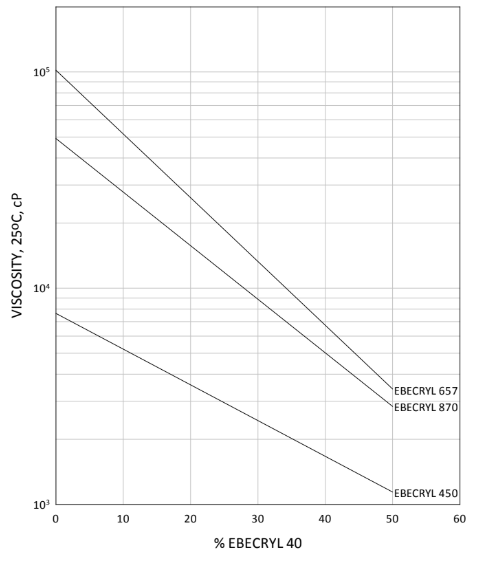Enhanced TDS
Identification & Functionality
- Blend
- No
- CASE Ingredients Functions
- Chemical Family
- Function
- Oligomer, Monomer
- Product Code
- MITM00403
- Single Ingredient
- Yes
- Technologies
- Product Families
Features & Benefits
- CASE Ingredients Features
- Labeling Claims
- Performance Highlights
EBECRYL® 40 is characterized by:
- Light color
- Low viscosity
- Low odor
- Good cure response
UV/EB cured products based on EBECRYL® 40 are characterized by the following performance properties:
- High surface hardness
- Good solvent resistance
- Low residual odor
- Reduced shrinkage
The actual properties of UV/EB cured products also depend on the selection of the other formulation components, such as reactive diluents, additives, and photoinitiators.
Applications & Uses
- Coating End Applications
- Compatible Substrates & Surfaces
- Cure Method
- Ink & Toner End Applications
- Markets
- Applications
- Product Applications
EBECRYL® 40 is commonly used as a diluting reactive oligomer in UV/EB cured coatings and inks. Effective levels of EBECRYL® 40 typically range from 10% to 50% depending on the application. In lithographic inks and varnishes it is quite effective in adjusting viscosity while maintaining or improving cure response and physical properties. EBECRYL® 40 is recommended for:
- Offset inks
- Overprint varnishes
- Coatings on paper, plastics
- Paper upgrading
- Reducing curl on flexible substrates
Properties
- Physical Form
Technical Details & Test Data
- Viscosity Reduction
Graph I - EBECRYL® 40 - Diluency effect on viscous oligomers

Graph I illustrates the viscosity reduction of several EBECRYL® oligomers used as lithographic ink vehicles when blended with an increasing weight percent of EBECRYL® 40
Packaging & Availability
Principal Information
- Group Principal Number
- S000001
- Principal
Storage & Handling
- Storage Conditions
Care should be taken not to expose the product to high temperature conditions, direct sunlight, ignition sources, oxidizing agents, alkalis or acids. This might cause uncontrollable polymerization of the product with the generation of heat. Storage and handling should be in stainless steel, amber glass, amber polyethylene or baked phenolic lined containers. Procedures that remove or displace oxygen from the material should be avoided. Do not store this material under an oxygen free atmosphere. Dry air is recommended to displace material removed from the container. Wash thoroughly after handling. Keep container tightly closed. Use with adequate ventilation.
Other
- Appearance
- Clear liquid
- Color (SDS)
- Clear pale yellow clear liquid
- Insoluble in (SDS)
- Water
- Item Number
- Odor
- Mild odor
- Odor (SDS)
- Ester like
- Other Hazards
- Polymerization may occur from excessive heat ,contamination or exposure to direct sunlight , Contact with skin may cause a cross-allergic reaction in persons already sensitized to acrylates.
- Protect from Freezing
- Yes
- Temperature Control
- Yes
- USA/DOT UN Number
- Not Applicable
- Mechanical Properties
Value Units Test Method / Conditions Elongation 4.0 % % at break, UV cured, approx. 125μ thick films Tensile Modulus 185000.0 psi psi at break, UV cured 125 μ thick films Tensile Strength 5200.0 psi psi - Optical Properties
Value Units Test Method / Conditions Color Scale max. 2.0 Gardner Gardner Gardner Color Scale - Physical Properties
Value Units Test Method / Conditions Density 1.15 g/mL g/mL at 25°C Flash Point min. 100.0 °C °C Cleveland Open Cup Glass Transition Temperature (Tg) 48.0 °C °C Dynamic Mechanical Analysis (DMA) at break, UV cured 125 μ thick films Storage Temperature 39.2-104.0 °F °F Viscosity 110.0-210.0 cPs cPs at 25°C - SDS Physical and Chemical Properties
Value Units Test Method / Conditions Boiling Point (SDS) min. 100.0 °C °C Density (SDS) 1.15 g/cm³ g/cm³ Vapor Pressure (SDS) 1.33 hPa hPa at 20°C Viscosity (SDS) 110.0-210.0 mPa.s mPa.s at 25°C pH (SDS) max. 0.3 - - Shelf Life & Stability
Value Units Test Method / Conditions Shelf Life 0.0 d d
